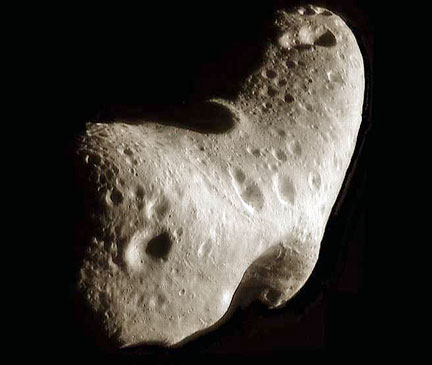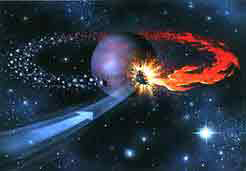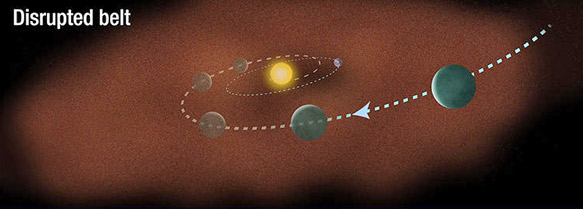Newsletter: Did Asteroid Impacts Make Earth Habitable?
Scientists suggest asteroid impacts may
have made life on Earth possible. If so, this is another fascinating
example of our existence hinging on a delicate balance of the nurturing
and annihilating forces of nature.

Look who's coming to dinner!
Asteroids’ devastating impacts are being
credited with providing Earth with water, organic compounds and other
vital materials. Such impacts may have stimulated the evolution of complex life on Earth, and may also have created the Moon, which stabilizes our seasons.
In a new report, Rebecca G. Martin and
Mario Livio from the Hubble Space Telescope Science Institute, suggest
that life may be possible only in planetary systems that have asteroid
belts with the right stuff. They say this may be quite rare, making our
solar system even more special than previously appreciated.
Martin and Livio focus on the “snow
line”, the distance from a star at which water freezes. Water freezes at
32°F on Earth’s surface, but at about –154°F in outer space. Inside the
snow line, planets are small and dry, like Earth, while the outside
planets are gas giants, like Jupiter. In our solar system, the snow line
is at 2.7 AU (Earth’s distance from the Sun is 1 AU). These astronomers
calculate that around other stars, the snow line would be at about the
same distance, as it varies only with the cube root of the star’s mass.
When Earth formed, it was molten. Heavy
elements, including many essential to life, such as iron, sank to
Earth’s core while water escaped into space. Even after cooling, Earth
would have been uninhabitable if not for asteroids.
Our story now shifts to Jupiter. With
over 300 times Earth’s mass, Jupiter’s gravity disrupts planet formation
in its vicinity. Thus the material that might have formed a planet near
the snow line instead became the asteroid belt. Famed UCB astronomer
Geoff Marcy estimates that only 20% of stars have a gas giant planet
that might produce a similar asteroid belt. Our asteroid belt may have
originally contained as much mass as Earth, 1000 times more than it has
now. Had that situation continued asteroids would now bombard us 1000
times more often, probably precluding any advanced life on Earth. Having
an asteroid wipe out the dinosaurs 65 million years ago, allowing the
ascension of mammals, was a good thing, but having an asteroid devastate
Earth every 65,000 years would be over-kill, so to speak.
But, asteroid belts can change
dramatically when gas giants migrate after forming. Since it formed,
Jupiter has probably moved 5% closer to the Sun. That seems modest, but
computer simulations show it was enough to eject 99.9% of the original
asteroids, many of which rained down on young Earth. This torrent
probably delivered most of Earth’s water, seeded the surface with heavy
elements like iron, and may even have delivered the building blocks of
life itself.
Most astronomers believe our Moon formed
from the debris of a cataclysmic impact by an asteroid named “Theia”
that ripped off much of Earth’s crust. Some suggest one of the first
consequences of Jupiter’s movement toward the Sun was pushing Theia our
way.

Asteroid Theia hitting and forming our Moon
Jupiter’s 5% movement may lie in a
“Goldilocks Zone” — less movement would have left too many asteroids
bombarding us today, and more movement would have disrupted the asteroid
belt and destabilized the orbits of the inner planets.
The asteroid belt that has enabled life on Earth is illustrated below.

The next image shows what Armitage et.
al. say happens to 98% of Jupiter-like gas giants: they migrate much
closer to their star, disrupting the asteroid belt, resulting in
frequent bombardment of the inner planets lasting billions of years,
with dire consequences for life.

Martin and Livio say only 4% of gas
giants in other star systems remain outside the snow line and that
includes planets that formed much farther out, as did our system’s other
gas giants: Saturn, Uranus, and Neptune.
Livio suggests scientists focus the
search for habitable exoplanets on planetary systems with: a gas giant
just beyond the snowline; and the infrared signature of a “warm”
asteroid belt.
Separately, astronomers estimate that
only 1% of stars are comparable to the Sun in mass, heavy element
abundance, and absence of stellar companions. Now factor in the
estimates that only 20% of such stars have appropriate gas giants, and
less than 2% of those are in the migration Goldilocks Zone. So far, our
type of solar system is 1 in 24,000. With 300 billion or so stars in our
galaxy, we could expect 12 million solar systems similar to ours. But
how many of those have habitable planets? No one knows for sure. In my
books, I list eight remarkable properties of Earth, beyond those
mentioned above. If the odds of satisfying each of the additional
requirements were 1 in 10, we would likely be alone in the Milky Way
galaxy. And, I think most of Earth’s additional properties are actually
much rarer than that — just consider the other planets in our
solar system.
All this highlights just how special is the place we share in the universe.
So, be Thankful and have a Happy Holiday!
Robert
Nov 19, 2012
|